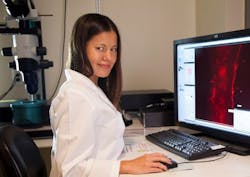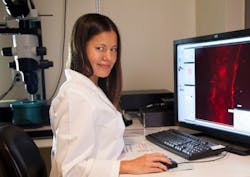Light microscopy method speeds brain, spinal cord measurements
Researchers at the University of Miami (Florida), as a part of the Miami Project to Cure Paralysis, have turned to a light microscopy method to help answer questions that help define human spinal cord injury and reveal strategies for the repair of damaged spinal tissue.
Related: Light-activated neurons control paralyzed muscles
Prof. Vance Lemmon, the Walter G. Ross Distinguished Chair in Developmental Neuroscience & Professor of Neurological Surgery at the University of Miami, is leading the work, as his lab studies nerve regeneration in the brain and spinal cord. Describing his work, he says, "We hope to make nerve cells regenerate much better than they normally do. My colleagues study scar formation in the cord, neural cell translation, and blood vessel formation after injury, while another colleague studies optic nerve regeneration."
The biggest challenge to Lemmon and his team is the ability to test literally thousands of samples each week in vitro and rapidly translate interesting "hits" into in vivo tests of efficacy. Imaging and analysis of many in vivo samples is vital to this work and this led to the introduction of light-sheet fluorescence microscopy (LSFM) to the team. As he says, "We always want to go faster! We needed to dramatically speed up the pace at which we can image large 3D volumes of the brain and spinal cord. Traditional methods are a bottleneck that limit discovery. While epifluorescence and confocal microscopies were useful, using LSFM enabled us to image way faster and much larger volumes can now be visualized."
"In our group, we have demonstrated the applicability of LSFM for comprehensive assessment of optic nerve regeneration, providing in-depth analysis of the axonal trajectory and pathfinding. Our study indicates significant axon misguidance in the optic nerve and brain, and underscores the need for investigation of axon guidance mechanisms during optic nerve regeneration in adults.1 Other colleagues have applied genetic lineage tracing, light-sheet fluorescent microscopy, and antigenic profiling to identify collagen1a1 cells as perivascular fibroblasts that are distinct from pericytes. The results identify collagen1a1 cells as a novel source of the fibrotic scar after spinal cord injury and shift the focus from the meninges to the vasculature during scar formation.2"
1. X. Luo et al., Exp. Neurol., 247, 653–662 (Sept. 2013); doi:10.1016/j.expneurol.2013.03.001.
2. C. Soderblom et al., J. Neurosci., 33, 34, 13882–13887 (Aug. 21, 2013); doi:10.1523/jneurosci.2524-13.2013.
-----
Follow us on Twitter, 'like' us on Facebook, connect with us on Google+, and join our group on LinkedIn
Subscribe now to BioOptics World magazine; it's free!

